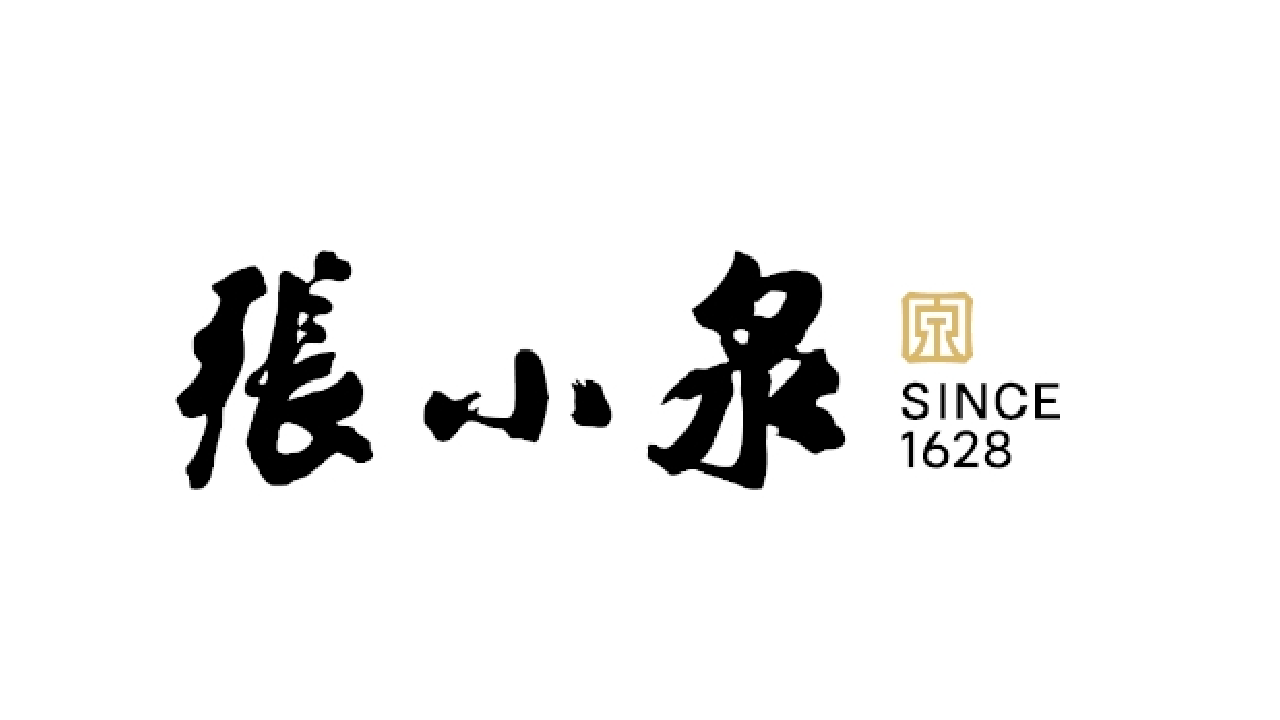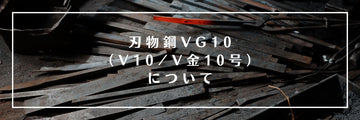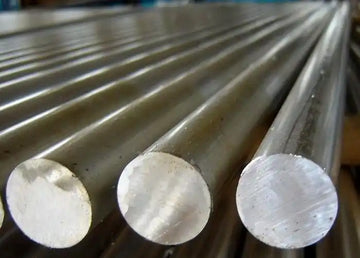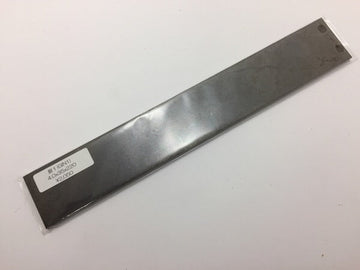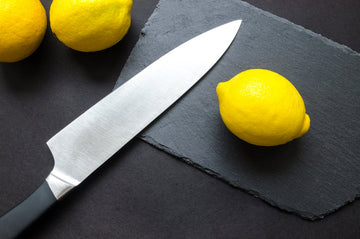In my hometown, we had a saying: "A dull knife cuts the hand, a sharp knife cuts the food." Simple words, but true. Like many things in life, the quality of a knife comes down to what's inside it - the steel at its core. Today, I want to tell you about VG-10 steel, a material with a story as fascinating as any character in a novel.
What Makes VG-10 Special?
VG-10 steel comes from Japan, made by Takefu Special Steel Company. The "VG" stands for "V Gold" - not because there's actual gold in it, but because to knife makers, this steel is as precious as gold.

If Steel were a village, VG-10 would be made up of these residents:
- Carbon (about 1%): The strong-willed elder who gives the steel its hardness
- Chromium (around 15%): The protective mother who keeps rust away
- Molybdenum (about 1%): The wise uncle who prevents little holes from forming
- Vanadium and Cobalt: The skilled craftsmen who make everything stronger and more refined

Together, they create steel that's hard (60-62 HRC, if you're counting), keeps its edge when cutting, and doesn't rust easily. It's like having a hardworking friend who never complains and rarely needs rest.
How VG-10 Performs in the Kitchen
Imagine you're cutting vegetables all day. A knife made of ordinary steel would get tired and dull as I do after writing for too many hours. But VG-10 keeps going. After cutting through 5 kilograms of vegetables, it still retains about 85% of its sharpness. That's better than many other steels like 440C or AUS-8.
When you sharpen it (using stones rated 1,000 to 6,000 grit), VG-10 responds well, though it requires some skill - like trying to convince a stubborn child to take a bath. The steel is hard, after all.
As for rust resistance, VG-10 stands up well to moisture, but like all of us, it has its limits. Leave it soaking in acidic foods or saltwater too long, and eventually, it will complain. And please, don't put it in the dishwasher - that's like asking a fine racehorse to pull a cart.
VG-10 Knives: What You'll Find
VG-10 appears in many types of knives:
- Gyuto or Santoku: All-purpose knives, like the village handyman who can fix anything
- Kiritsuke or Yanagiba: Single-edged slicing knives, precise as a calligrapher's brush
- Damascus Steel Knives: Beautiful layered creations, where VG-10 serves as the reliable heart beneath a decorative exterior
These knives usually cost between $100 and $600, made by respected brands like Shun and Sakai Takayuki. Not cheap, but then again, neither is a reliable friend.
VG-10 Steel Compared: Chinese, Japanese, and German Kitchen Knife Steels
VG-10 (V Gold 10) steel stands as a benchmark in premium kitchen cutlery. To understand its true value and performance, let's compare it with popular knife steels from China, Japan, and Germany - the three major knife-producing regions.
VG-10 vs Chinese Kitchen Knife Steels
Chinese manufacturers have developed several steel formulations that compete in the global kitchen knife market. Here's how VG-10 compares to popular Chinese stainless steels:
5Cr15MoV
- Hardness: VG-10 (60-62 HRC) vs 5Cr15MoV (54-56 HRC)
- Edge Retention: VG-10 significantly outperforms 5Cr15MoV, maintaining sharpness 2-3 times longer
- Corrosion Resistance: Both provide good resistance, but VG-10's higher chromium content (15% vs 14-15%) gives it a slight edge
- Ease of Sharpening: 5Cr15MoV is easier to sharpen but doesn't hold an edge as long
- Cost: 5Cr15MoV is significantly less expensive, often used in budget knives under $40
- Best For: VG-10 suits professionals and enthusiasts; 5Cr15MoV works for casual home cooks on a budget
7Cr17MoV
- Hardness: VG-10 is harder (60-62 HRC vs 56-58 HRC)
- Edge Retention: VG-10 retains its edge approximately 70% longer in typical kitchen tasks
- Corrosion Resistance: 7Cr17MoV has excellent rust resistance (17-18% chromium), slightly better than VG-10
- Toughness: 7Cr17MoV is less brittle and can withstand more abuse
- Applications: 7Cr17MoV appears in mid-range Chinese cleavers and chef's knives ($40-80)
- Key Difference: VG-10's cobalt content provides performance advantages that 7Cr17MoV lacks
8Cr13MoV
- Composition: Often called "Chinese 440C," it lacks the cobalt and vanadium balance of VG-10
- Hardness: 8Cr13MoV reaches 57-59 HRC, still below VG-10's 60-62 HRC
- Performance: VG-10 holds an edge approximately 50% longer in slicing tests
- Practical Use: 8Cr13MoV performs well for its price point ($30-70) but can't match VG-10's refined cutting feel
- Market Position: Common in entry-level Shibazi and Dengjia knives
9Cr18MoV
- Composition: Higher carbon and chromium than 8Cr13MoV, approaching VG-10 quality
- Hardness: Can reach 58-60 HRC, closer to VG-10
- Edge Retention: About 75-80% of VG-10's performance in controlled cutting tests
- Corrosion Resistance: Excellent (18% chromium), better than VG-10
- Price-Performance Ratio: Offers excellent value at $60-120 price points
- Notable Difference: Lacks VG-10's cobalt, which contributes to microstructure refinement
10Cr15CoMoV
- Closest Match: Most similar to VG-10 among Chinese steels, containing cobalt
- Hardness: Can reach 60-61 HRC, very close to VG-10
- Cutting Performance: Approximately 90% of VG-10's edge retention
- Corrosion Resistance: Slightly less than VG-10 due to lower chromium
- Grain Structure: More variable than VG-10's consistent grain pattern
- Market Presence: Used in higher-end Chinese knives ($80-150)
VG-10 vs Japanese Kitchen Knife Steels
Japan produces some of the world's finest knife steels, ranging from traditional carbon steels to modern stainless varieties. Here's how VG-10 compares:
Blue Steel (Aogami) Series
Blue Steel Super, Blue Steel #1, Blue Steel #2
- Hardness: Blue Steel Super can reach 64-65 HRC, exceeding VG-10's 60-62 HRC
- Edge Retention: Aogami Super outperforms VG-10 by 30-40% in edge retention
- Corrosion Resistance: VG-10 dramatically outperforms all Aogami steels, which require immediate cleaning and care
- Sharpness: Blue Steel can achieve finer, keener edges than VG-10
- Toughness: Blue Steel Super is more brittle than VG-10; Aogami #2 offers better toughness
- Maintenance Requirements: VG-10 requires significantly less maintenance
- Best Applications: Blue Steel excels for sashimi and precision work; VG-10 offers better all-around performance
White Steel (Shirogami) Series
White Steel #1, White Steel #2, White Steel #3
- Composition: White Steel is nearly pure carbon steel, while VG-10 is a complex stainless alloy
- Hardness: White Steel #1 can reach 61-63 HRC, similar to VG-10
- Purity: White Steel has fewer alloying elements, creating a "pure" cutting feel many chefs prefer
- Edge Retention: Despite similar hardness, VG-10 typically outlasts Shirogami in edge retention
- Corrosion Resistance: VG-10 far surpasses Shirogami, which can rust within hours if not properly maintained
- Sharpening: White Steel is significantly easier to sharpen to a razor edge
- Ideal Uses: White Steel for traditional Japanese cuisine; VG-10 for versatile modern kitchen use
Silver Steel (Ginsan/Gingami) Series
Silver Steel #1, Silver Steel #3
- Composition: Both are stainless steels; Ginsan has higher carbon content
- Hardness: Silver #1 reaches 60-62 HRC, matching VG-10
- Edge Feel: Ginsan provides a sharper, carbon-like cutting feel despite being stainless
- Edge Retention: Nearly identical in testing, with VG-10 showing slightly better retention in acidic foods
- Rust Resistance: Both excellent; Ginsan slightly better in saltwater tests
- Ease of Sharpening: Ginsan is easier to sharpen and deburr
- Key Difference: VG-10's cobalt content creates a more wear-resistant edge; Ginsan offers a "purer" feeling cut
AUS-10 and AUS-8
- Chemical Similarity: AUS-10 is similar to VG-10 but lacks cobalt
- Hardness: AUS-10 (58-60 HRC) and AUS-8 (56-58 HRC) vs VG-10 (60-62 HRC)
- Edge Retention: VG-10 outperforms AUS-10 by 25-30% and AUS-8 by 45-50%
- Corrosion Resistance: Similar for all three, with excellent kitchen performance
- Cost-Performance Ratio: AUS-8 offers excellent value; AUS-10
- Common Applications: AUS-10 appears in mid-range Japanese knives ($70-150)
- Trade-offs: AUS steels offer easier sharpening with less edge retention than VG-10
VG-10 vs German Kitchen Knife Steels
German knife steels focus on toughness and ease of maintenance, creating a different philosophy than Japanese designs. Here's how VG-10 compares:
X50CrMoV15
- Hardness: VG-10 (60-62 HRC) vs X50CrMoV15 (54-56 HRC)
- Edge Retention: VG-10 maintains sharpness significantly longer
- Toughness: X50CrMoV15 resists chipping better, suitable for heavy-duty tasks
- Sharpening: X50CrMoV15 sharpens more easily but to a less acute angle (typically 20° vs 15° for VG-10)
- Common Uses: X50CrMoV15 excels in rock chopping and bone work where VG-10 would risk chipping
- Prominent Brands: Wüsthof, Henckels, and Mercer use X50CrMoV15 extensively
- Price Point: Both appear in $100-200 knives, with different performance characteristics
X55CrMo14
- Carbon Content: Higher than X50CrMoV15 but lower than VG-10
- Hardness: Typically 56-58 HRC, below VG-10
- Edge Performance: Good initial sharpness but requires more frequent maintenance than VG-10
- Impact Strength: Significantly tougher than VG-10, resists deformation under heavy impact
- Weight and Feel: Heavier than VG-10 knives, providing more momentum in cuts
- Best Applications: Excels in European cooking techniques; VG-10 better for precision slicing
Cronidur 30
- Composition: High-nitrogen martensitic steel, more corrosion-resistant than VG-10
- Hardness: Can reach 58-60 HRC, approaching VG-10
- Wear Resistance: Exceptional wear resistance, comparable to VG-10
- Corrosion Resistance: Superior to VG-10, especially in marine environments
- Cost: Significantly more expensive than VG-10, appearing in premium German knives ($200+)
- Performance Balance: More flexible than VG-10 while maintaining good edge retention
- Market Position: Primarily used in premium Robert Herder and Messermeister lines
1095
- Composition: Simple carbon steel with minimal alloying elements
- Hardness: Can be heat-treated to 60-62 HRC, similar to VG-10
- Edge Performance: Takes an extremely keen edge but dulls faster than VG-10
- Maintenance: Requires immediate cleaning and oiling, unlike low-maintenance VG-10
- Cost: Significantly less expensive to produce than VG-10
- Traditional Use: Common in traditional German hunting and outdoor knives rather than kitchen blades
- Key Difference: 1095 offers a more "direct" feedback and tactile cutting experience
4116 Thyssen-Krupp Stainless
- Industry Position: Widely used in commercial German kitchen knives
- Hardness: 54-56 HRC, considerably softer than VG-10
- Edge Retention: About 40-50% of VG-10's performance
- Corrosion Resistance: Very good, though slightly below VG-10
- Commercial Applications: Common in institutional kitchens where frequent resharpening is available
- Cost Efficiency: Significantly less expensive than VG-10
- Brands: Used in Victorinox, F. Dick, and entry-level Wüsthof lines
Comparative Performance Summary
| Performance Factor | VG-10 | Top Chinese (10Cr15CoMoV) | Top Japanese (Aogami Super) | Top German (Cronidur 30) |
|---|---|---|---|---|
| Hardness (HRC) | 60-62 | 60-61 | 64-65 | 58-60 |
| Edge Retention | Excellent | Very Good | Outstanding | Good |
| Corrosion Resistance | Excellent | Very Good | Poor | Outstanding |
| Ease of Sharpening | Moderate | Moderate | Difficult | Moderate |
| Toughness/Chip Resistance | Good | Good | Poor | Excellent |
| Price Range (USD) | $100-600 | $80-150 | $150-800 | $200-500 |
| Best Kitchen Applications | All-purpose, precision | All-purpose | Precision slicing, sashimi | Heavy chopping, all-purpose |
Conclusion: Where VG-10 Excels
VG-10 represents an excellent middle ground between Western and Eastern knife traditions:
-
Compared to Chinese Steels: VG-10 offers superior edge retention and refined cutting performance, albeit at a higher price point. 10Cr15CoMoV comes closest in performance.
-
Compared to Japanese Steels: VG-10 provides better corrosion resistance and ease of maintenance than traditional carbon steels while delivering better edge retention than other stainless options like AUS-8/10.
-
Compared to German Steels: VG-10 holds a sharper edge longer and enables thinner blade geometries, though it sacrifices some of the toughness and heavy-duty performance of German steels.
For users seeking a premium knife that balances sharpness, edge retention, and corrosion resistance without extreme maintenance requirements, VG-10 remains an outstanding choice. Its position as a "Goldilocks steel" explains its enduring popularity among both professional chefs and serious home cooks worldwide.
Taking Care of Your VG-10 Knife
Caring for a VG-10 knife is simpler than raising children, but still requires attention:
- Wash it by hand: Use mild soap, not harsh chemicals
- Dry it immediately: Don't let water sit on it, like you wouldn't let a child play in the rain too long
- Store it properly: Use knife guards or magnetic racks, not jumbled in a drawer where edges can hit each other
- Sharpen with care: Start with 1,000 grit stones for repairs, finish with 6,000+ for a mirror polish
The Challenges of VG-10
Like any character in life, VG-10 has its flaws:
- Very thin edges might chip if you hit bone or frozen foods (the steel is hard but can be brittle)
- Some dishonest sellers claim their knives are VG-10 when they're not - like a person who pretends to be from a famous family
But innovations continue:
- Some makers use extreme cold treatments to make VG-10 tougher
- Others sandwich it between softer steels for protection, like putting a valuable painting in a sturdy frame
The Simple Truth About VG-10
VG-10 steel is neither the hardest nor the toughest steel in the world. But like the most memorable characters in life, it's well-balanced. It offers sharpness that lasts, resistance to rust, and enough strength for daily kitchen tasks.
For professional chefs who cut for hours, home cooks who want reliability without constant maintenance, or knife enthusiasts who appreciate both beauty and function, VG-10 offers an honest partnership.
In the end, isn't that what we all want? Something reliable that doesn't demand too much from us, yet performs when called upon. In the world of knife steels, VG-10 is that faithful companion.
FAQs
Is VG10 a good steel?
Yes, VG-10 is considered an excellent knife steel for kitchen knives. It offers a great balance of hardness, edge retention, corrosion resistance, and price. It's particularly valued for its ability to take a very sharp edge while being more stain-resistant than many high-performance steels.
What is VG-10 steel?
VG-10 is a premium Japanese stainless steel made by Takefu Special Steel Co. It contains approximately 1% carbon, 15% chromium, and additions of molybdenum, vanadium, and cobalt. The "VG" stands for "V Gold," and it was designed specifically for high-end kitchen cutlery.
Is VG10 hard to sharpen?
VG-10 requires moderate effort to sharpen. It's harder than most German steels (60-62 HRC), so it takes more work than softer steels, but it's not as difficult as super steels like S30V or ZDP-189. With proper technique and stones, most users can sharpen VG-10 successfully.
Is VG10 real Damascus?
No, VG-10 itself is not Damascus steel. However, VG-10 is often used as the core steel in Damascus-patterned knives, where it's clad with layers of softer patterned steel. True Damascus is pattern-welded steel throughout, while these VG-10 knives are technically "Damascus-clad."
Is VG10 a high-carbon steel?
Yes, VG-10 is a high-carbon stainless steel with approximately 0.95-1.05% carbon content. This carbon level allows it to achieve high hardness (60-62 HRC) while its chromium content (15%) ensures good corrosion resistance.
Will VG10 rust?
VG-10 has excellent corrosion resistance and will not rust easily under normal use. However, it can still rust if exposed to prolonged contact with acids, saltwater, or if left wet for extended periods. It's significantly more rust-resistant than carbon steel but requires basic care.
How do you care for VG10 steel?
- Hand wash with mild detergent and dry immediately
- Avoid dishwashers and soaking in water
- Keep away from acidic foods for extended periods
- Store in a dry place or knife block
- Use a honing rod occasionally to maintain the edge
- Sharpen when needed using water stones (1000-6000 grit)
Is VG10 better than D2?
VG-10 and D2 have different strengths. VG-10 offers better corrosion resistance and easier sharpening, while D2 typically provides somewhat better edge retention. For kitchen knives, VG-10 is generally preferred. For outdoor knives, D2 might be preferred for its wear resistance, though it will patina more easily.
VG-10 vs S30V
- Edge Retention: S30V is superior (about 20-30% better)
- Corrosion Resistance: Both excellent, with S30V slightly better
- Ease of Sharpening: VG-10 is significantly easier to sharpen
- Toughness: S30V is tougher and less prone to chipping
- Price: VG-10 knives are typically less expensive
- Best For: VG-10 for kitchen knives; S30V for premium outdoor/pocket knives
VG-10 vs D2
- Edge Retention: D2 holds an edge slightly longer
- Corrosion Resistance: VG-10 is significantly more stain-resistant
- Ease of Sharpening: VG-10 is easier to sharpen
- Toughness: D2 has slightly better toughness
- Price: Similar in most knives
- Best For: VG-10 for kitchen use; D2 for heavy-duty cutting tasks
VG-10 vs S35VN
- Edge Retention: S35VN is superior (about 25-35% better)
- Corrosion Resistance: Both are excellent, with S35VN slightly better
- Ease of Sharpening: VG-10 is easier to sharpen
- Toughness: S35VN is significantly tougher
- Price: VG-10 knives are less expensive
- Best For: VG-10 for kitchen knives; S35VN for premium outdoor/EDC knives
VG-10 vs AUS-10
- Edge Retention: VG-10 is better by about 15-20%
- Corrosion Resistance: Very similar performance
- Ease of Sharpening: AUS-10 is slightly easier to sharpen
- Toughness: Similar, with AUS-10 possibly slightly tougher
- Price: AUS-10 knives are typically less expensive
- Best For: VG-10 for higher-end performance; AUS-10 for value
VG-10 vs VG-MAX
- Edge Retention: VG-MAX is better by about 10-15%
- Corrosion Resistance: Very similar performance
- Ease of Sharpening: VG-10 is slightly easier to sharpen
- Toughness: VG-MAX has improved microstructure for better toughness
- Price: VG-MAX knives are typically more expensive
- Best For: VG-MAX is Shun's proprietary improved version of VG-10, offering incremental improvements
